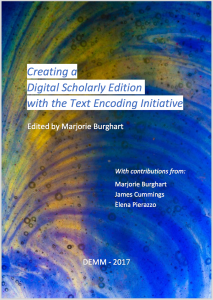Online course: Digital Scholarly Editions: Manuscripts, Texts, and TEI Encoding
These two resources stem from the DEMM experience: an online course, “Digital Scholarly Editions: Manuscripts, Texts, and TEI Encoding”, and an open access textbook, “Digital Editing of Medieval Texts: A Textbook”. The course and the textbook are ideal companions to each other.
You can access the online course here. Note – you can access the course as a “Guest”, or use your own shibboleth login.
This course, which constitutes one of the outputs of the Erasmus SP+ DEMM and benefited from its experience, has been supported by the european projects DARIAH Humanities at Scale (integration of the training material into the #dariahTeach platform), the ITN DiXiT (translation of subtitles in other languages), the TEI Consortium and the Institut des Sciences de l’Homme. It is published on the #dariaTeach plateform, a European initiative which groups together peer-reviewed teaching material for Digital Humanities.
Digital Editing of Medieval Texts: A Textbook
This textbook was born from the experience of the Digital Editing of Medieval Manuscripts
(DEMM) programme, an Erasmus SP+ project funded by the European Union. From 2014 to

2017, the partners of this programme had the opportunity to teach digital methodologies and
technologies to international groups of young scholars interested in producing various types of
digital editions of medieval texts and documents.
This textbook is our way to share with the DH community the courses and material we prepared
for this programme. It is an ideal companion to the online course Scholarly Digital Editions:
Manuscripts, Texts and TEI Encoding, freely available on the #dariahTeach platform.2 If the
official Guidelines remain the main resource about the encoding of digital editions in TEI, both
this book and the online course offer a different approach by targeting the particular needs of
editors of medieval (and more generally manuscript) sources, and translating them into TEI
terms.
We want to thank all the people who contributed to this experience, not least of all the DEMM
students. Particular thanks go Martin Haltrich and the staff of the Stiftsbibliothek
Klosterneuburg, who helped us gather relevant examples from their manuscript collections,
and kindly contributed the images to this volume.
Table of Contents
1. Structure and Layout by Marjorie Burghart. Including:
- The general structure of a TEI document
- How to represent the physical and logical structure of your document and/or text
- A first hint at the resolution of concurrent hierarchies.
2. Transcription or Diplomatic Edition by Marjorie Burghart. Including:
- How to encode the transcription or diplomatic edition of a single manuscript document
- How to represent various features and interventions, either by the original scribe or by the editor
- How to encode a damaged document with poorly legible or illegible text.
3. Manuscript Description by James Cummings.
- This chapter investigates the creation of manuscript descriptions for digital editions through looking at the recommendations of the Guidelines of the Text Encoding Initiative for manuscript description. By detailing the methodology of encoding a manuscript description, we examine the basic categories and level of detail necessary to produce a competent scholarly description of the object or objects that are the source for our editions. This chapter looks at when manuscript descriptions are provided and what forms these take. It looks at how to encode such descriptions (using the TEI) to identify a manuscript, record the manuscript contents, detail the physical description, document its history, and provide additional information. The chapter concludes with brief thoughts on publishing manuscript descriptions.
4. Textual variants (MB) by Marjorie Burghart. Including:
- How to understand a traditional printed edition and its conventions
- How to encode textual variants according to different methods and styles
- How to solve several special cases common in critical editions
5. Facsimile and Document-Centric Editing by Elena Pierazzo.
- Digital facsimiles have become ubiquitous in editorial practices, whether the outcome is to be in digital form only or in print or both. This chapter explores the ways the TEI handles the use of facsimile within the production of digital editions, and connects them to different theoretical editorial approaches and conceptions. Readers will learn ho to establish a relation between a portion of a text and a digital facsimile or a portion of it; they will learn how to zone an image and also how to embed a transcription within an image; they will lastly learn how to document and time the process of producing a text.
6. Citations and References, by Marjorie Burghart. Including:
- To encode the sources used or referred to in a text, and link them to bibliographic citations
- To encode the biblical references, and represent them as canonical references
- To handle overlapping hierarchies if they occur